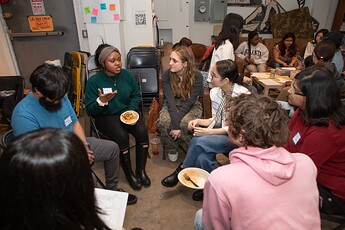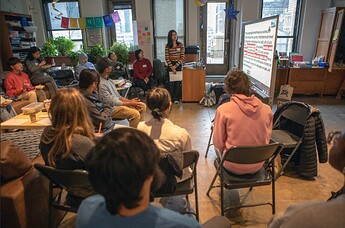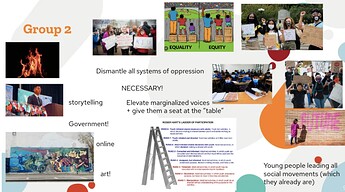Youth Power Coalition held their first in-person Youth Power Convening, and their first online Youth Power Convening in a while, in collaboration with other youth organizations. The in-person convening was held in collaboration with the Peer Defense Project (PDP), Youth Alliance for Housing (YAH), and NYU’s EJ-ROC. The online convening was held in collaboration with the Provisional World Children’s Parliament (PWCP). Both convenings centered around the discussion of one question: How might we be radical for youth-led change?
Led by Aneth Naranjo, the co-founding executive of PDP, and Erina Chowdhury, the Youth Executive Director of YPC, the in-person convening took place at Ya-Ya Network in the heart of Manhattan. Photographer Gerard Gaskin was present, snapping pictures of the insightful discussions and engaging activities throughout the two-hour event. The convening acted as a space for members from various youth organizations to come together to socialize and talk with each other about their thoughts and ideas on the topic of youth radicalism. Chipotle and cranberry juice were provided, with many opting to fill their Chipotle bowl and grab a cup of juice before joining the circle. Members were given name tags to fill out with their name, organization, and pronouns so that everyone could be easily identified.
The convening kicked off with a wellness circle, led by Aneth. The chairs were set up in a circle formation, enabling everyone to be able to be seen and heard clearly. An introduction round followed the wellness circle --with individuals breaking off into small groups to introduce themselves and gain a sense of community with those in the room.
After introductions, post-it notes and markers were handed out and people walked around the room, reading and answering the various prompts taped to the walls of the space. Questions such as “How would you define being radical for youth-led change?” and “How do you envision the future of youth radicalism?” allowed the youths to think thoroughly and critically about their responses. The activity also prompted those who were more introverted to share their ideas. Once everyone returned to the circle, those who felt comfortable read their responses out loud to the circle and expanded on their thoughts.
Following the group discussions, everyone moved from the circle to the couch area and gathered around the projector to watch the History of Being Radical video, created by PDP. The video discussed previous monumental changes that were made thanks to the contribution of youth radicalism.
After watching the video, the youths split into two large groups to share their answers to the questions that were provided. The groups gathered in circle formations, with one group gathering around the couch and the other placing their chairs to form a circle.
Discussions centering around youth radicalism and the unique stories and experiences that each person had to share were prompted by the questions. The discussions went in rounds, with each person being given the time to speak without interruption. After the rounds were over, those who had any additional ideas on a question were able to speak freely. By sharing their similar experiences, the youths were provided with a sense of community and relatability, which allowed them to feel more comfortable in the space.
In one group, a discussion about the desensitization of media began. Youths shared their experiences with tuning out the atrocities that the news covered, as it has become a new normal. Desensitization, along with distrust towards large media corporations has led to many people to turn the other way in regard to the issues that are going on around the world. Youths around the world are handed the duty of reigniting the concern of the public towards the serious issues that people around the world, and people within their own communities, experience.
With warm and gooey brownies baking in the oven, people began to mingle and chit-chat with one another after the convening had concluded. A QR code to a feedback form was projected on the board, with each person scanning the code and filling it out before leaving. The Ya-Ya Space provided plenty of room for youths to walk around and socialize with their peers. Those who remained were able to enjoy the delicious brownies and go out on the rooftop to admire the foggy, but still beautiful views that the building had to offer.
From a personal perspective, the in-person convening gave me the opportunity to meet new people and the people that I had been talking with over a screen for months. After spending weeks seeing my fellow youth leaders over a screen, I was happy to be able to see them in person and socialize with them. Aside from those who were in my organization, I was able to meet new people from other organizations at the convening. I recall spending most of my time talking to Grace, a member of Teens Take Charge (TTC). I began talking to Grace after PDP’s History of Being Radical video was played, and we turned to discuss our takeaways from the video with each other. After we moved from the couch, we naturally continued our discussions and began to form real connections with each other. The experience of being in a space with youths and adult allies that shared my goals and ambitions was both refreshing and rewarding. I was able to express my opinions, and in turn be able to hear what my peers had to say. The conversation about media desensitization, for example, made me realize the prevalent issues of distrust and desensitization in the media. Without attending the convening, I would have likely never come to this realization.
In collaboration with the Provisional World Children’s Parliament (PWCP), the online convening took place over Google Meets two weeks after the in-person convening. While YPC had attended online events like this in the past, this was the first in a while, so there was a sense of nostalgia for many of the participants.
The online convening started off with folks sharing their definition of youth radicalness. The circle went into a round, with each person taking their time to share their thoughts without interruption. One member, Kennedy, defined youth radicalism as “pushing the status quo of those things [policies, ideals, and concepts] surrounding our youth…that affect our youth directly.” Another participant, Jolina, summarized youth radicalness as “cyclic…go[ing] hand in hand with it being transformative.” The overall consensus on the definition of youth radicalness was that it was transformative and progressive --pushing for a greater degree of inclusivity. The phrase “status quo” was referenced several times during the round, accompanied with the goal of conquering and breaking said status quo. Youth radicalness can be defined as the breaking down of long-standing societal boundaries, along with the uplifting of marginalized voices that have historically been disregarded and suppressed by society.
The Google Meets split into two breakout rooms, with each group creating their own vision boards on their vision of youth radicalism and the future of youth-led radicalism. Those in the first breakout room depicted their view of the future of youth-led radicalism as “a larger expansion of organizations connecting people all across the world pushing for change together --nationally.”
Group One’s vision board focused on the big picture of youth radicalism --incorporating single words such as “transformative” and “solidarity” that encapsulate individual elements of youth radicalism. Group Two’s vision board focused on the efforts of the youth radicalism movement --including phrases such as “elevat[ing] marginalized voices” and “dismantl[ing] all systems of oppression” that detail the methods that youth radicalists use in order to uplift the voices of the youth.
Group Two included the Hart’s Ladder of Participation --a theory that depicts the increasing levels of power and control over decision-making that adults can give to children-- in their vision board. The ladder utilizes the rungs of a ladder to illustrate the varying levels that can be given, with the top rung being “youth initiated shared decisions with adults.” Hart’s Ladder is useful in breaking up the main objectives of youth radicalism into simpler concepts --making it easier to digest for outsiders and newcomers to the movement.
After presenting the vision boards, another round began, centering around the question of where youth radicalism could be seen in society. Reana (YPC) and Erina shared that youth radicalism can be seen through artistic expression, such as art, poetry, and music. Art has long been used as a form of human expression, and it is no stranger to the world of youth radicalism. Reana touched upon the utilization of art as storytelling in youth radicalism, with many letting their artwork speak for them. Numerous artists have incorporated radical messages in their work in order to bring attention to the cause that they are standing for. Youth radicalism can also be seen through the dismantlement of all systems of oppression, using techniques such as protests and social media campaigns in order to raise awareness for a movement.
When discussing the challenges of youth radicalism, the glamorization of youth radicalism and the lack of accountability towards youth initiatives were both emphasized.
The glamorization of youth radicalism was noted as a big challenge by multiple members of the convening. Erina shared her experience of being used as a quote or photo op in adult-centric environments rather than being taken seriously and listened to. She expanded on the topic --sharing her experience with being made fun of when she tried to be assertive, which can be discouraging to many young advocates. The lack of respect that many have towards the youth oftentimes undermine the work and effort that they put into advocating for change.
Jolina talked about her struggle of having her voice heard when working with elected officials. In order to be taken seriously, she had to phrase her ideas with verbiage in order for them to be seen as less “scary” to the elected officials that she works with. She has to find a balance between her identities as a youth and a progressive, and the officials that she works with who do not share those identities. Not being taken seriously and being underestimated are serious challenges that youth advocates face while fighting for change.
Reana shared the challenge of many youth initiatives never being followed through and the empty solutions that elected officials propose. Many initiatives are started, but fail to get fully up and running because of the lack of accountability that youth organizers hold towards elected officials. In order to actually get things done and change to happen, accountability needs to happen. The cycle will only continue if no one feels responsible for going through with the initiatives.
Myths surrounding youth radicalness were also discussed. Kyle, a principal, shared the myth that “youth allyship or leadership is necessary for youth to be successful.” In schools, all clubs are required to have a teacher sponsoring or monitoring it in order to be legitimate. Kyle shared that his school has student equity teams, but the activities are still organized by adults.
As the convening came to an end, another round was started focusing on what new ideas people were walking away with. Many people shared that they were walking away from the convening with new ideas regarding adult allyship. One youth noted that they enjoyed having adult allies in their organizations, despite it not being necessary. The presence of an adult ally is meant to act as the support for the youth who are the leaders of the change.
The convening closed off with a round of last words that each person had about the youth convening. “Inspired,” “thoughtful,” and “motivated” were all included in the last words, and gave a sense of the productivity of the convening.
Both the online and in-person convening provided a space for insightful and engaging conversations amongst youth organizers. The supportive atmosphere of both convenings allowed everyone to feel at ease sharing their opinions without fear of judgment or harsh criticism. The prompts of the convenings allowed for stimulating conversations and discussions regarding youth radicalness to take place. In both convenings, the rounds that were opened allowed youth organizers to walk away from the events with a gain of knowledge and ideas from their fellow peers. The importance of engaging with other youth organizers and hearing new perspectives was emphasized through the convenings, as it provided people with the opportunity to develop a sense of community with their peers in the world of youth power.



